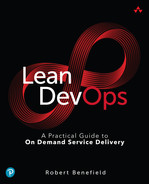Contents
Chapter 2: How We Make Decisions
-
Chapter 8: Embarking on the DevOps Journey
Chapter 9: Service Delivery Maturity and the Service Engineering Lead
-
-
Chapter 14: Cycles and Sync Points
-
..................Content has been hidden....................
You can't read the all page of ebook, please click here login for view all page.
